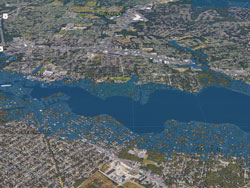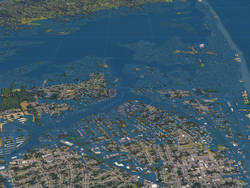The Monmouth University Urban Coast Institute (UCI) encourages costal community members to prepare for the future of flooding along the New Jersey shoreline.
In 2017, Climate Central, a nonprofit that produces research on sea level change, released photos of different areas of the New Jersey shoreline that research suggests will be submerged in sea water by 2100.
Tom Herrington, Associate Director of the UCI, said that rising sea levels are of concern to shore communities now, and will be of major concern by the year 2050.
“People in coastal communities should know that their risk of being impacted by a flood is increasing every year,” said Herrington.
To reduce the detrimental risk of living in the shore communities potentially affected, community members should have flood insurance, live in elevated homes built on pilings, be aware of the impacts of coastal storms in their area, and have the ability to evacuate and live away from their home for a period of time, Herrington recommended.
Despite current controversy on the causes of global warming, the global rise in temperature itself has been proven across various organizations, including the United States Environmental Protection Agency (EPA), which has published climate change indicators across the United States. That data shows an exponential rise in atmospheric temperature.
 The EPA data also shows that the temperature is growing warmer, faster, in the most recent years.
The EPA data also shows that the temperature is growing warmer, faster, in the most recent years.
The rising temperature of the earth causes heat to be absorbed by the ocean which melts land and sea ice glaciers, which means less solid water, and more liquid, which causes sea levels to rise.
Sea level rising causes flooding in shore towns when storms happen, when high tide occurs, and loss of land mass gradually. Filling beaches with sand to combat this rise is both economically unsustainable, and unlikely to protect shore communities from the effects of flooding over the next years.
“Low lying portions of Atlantic City used to flood 4 to 6 times a year 50 years ago, now they flood over 24 times per year. By 2040 the number of flood events may increase to between 50 and 75 events per year depending on how fast sea level rises in the future,” said Herrington.
Families affected by increased flooding struggle to leave the house for daily activities, and property damage often accompanies these floods.
 Seventy-eight percent of the Mid-Atlantic economy is due to ocean economy employment and tourism. As the sea levels continue to rise, it is predicted that the 120,000 jobs and $20 billion in GDP projected for the year 2030, in these industries will be at risk, according to research done by the Mid-Atlantic Regional Council on the Ocean (MARCO) and the UCI for “Planning for a Changing Ocean.”
Seventy-eight percent of the Mid-Atlantic economy is due to ocean economy employment and tourism. As the sea levels continue to rise, it is predicted that the 120,000 jobs and $20 billion in GDP projected for the year 2030, in these industries will be at risk, according to research done by the Mid-Atlantic Regional Council on the Ocean (MARCO) and the UCI for “Planning for a Changing Ocean.”
Fisherman will potentially lose 25 percent of their catch due to unpredictable changing habitats in the ocean, “Planning for a Changing Ocean,” also suggests.
The Great Barrier Reef Marine Park Authority of Australia recognizes that the rising temperatures of the ocean will negatively affect fish populations as well, which will affect a large part of the New Jersey’s and global, fisherman’s livelihoods.
The dangers of flooding at Monmouth University itself is unlikely within the nearest upcoming years because the university is located high up on the coastal bluff of Monmouth County and is more than a mile from the coast. However, the University Bluffs Apartments may be impacted during coastal storms in the future according to Herrington.
Elizabeth Newcombe, a senior business marketing and management student, said, “I have lived in the Bluffs for years, and when it storms you can feel the wind from inside, and the rain is especially harsh here at the beach. With rising sea levels in mind, if I were going to Monmouth in 20 years, I would not feel comfortable living there.”
 With increasing sea levels, there will be higher storm tides that allow large waves to more frequently reach and erode the coastal bluff. This could cause loss of the boardwalk and the road along the top of the bluff over time.
With increasing sea levels, there will be higher storm tides that allow large waves to more frequently reach and erode the coastal bluff. This could cause loss of the boardwalk and the road along the top of the bluff over time.
The low-lying areas of Monmouth County and the Jersey shore will see more frequent flooding, more days of road closures, more utility impacts, and increasing vulnerability impacts from even weak coastal storms, said Herrington.
“We can’t stop sea level rise but we can learn to adapt our communities to ‘live with the water,’” said Herrington.
“This is a concept that the Dutch now use and is founded on the assumption that communities will flood in the future and that we need to adapt our buildings to be above the flood levels and public spaces to be able to store and convey water away from areas that it may impact. A great example of this is Venice, Italy, but they are even having trouble keeping up,” Herrington continued.
IMAGES TAKEN from the Asbury Park Press




